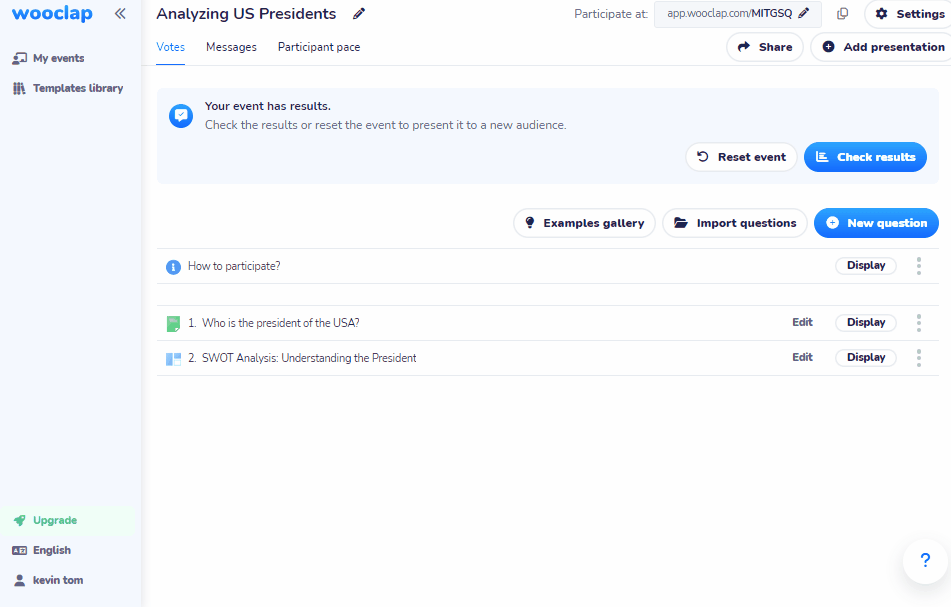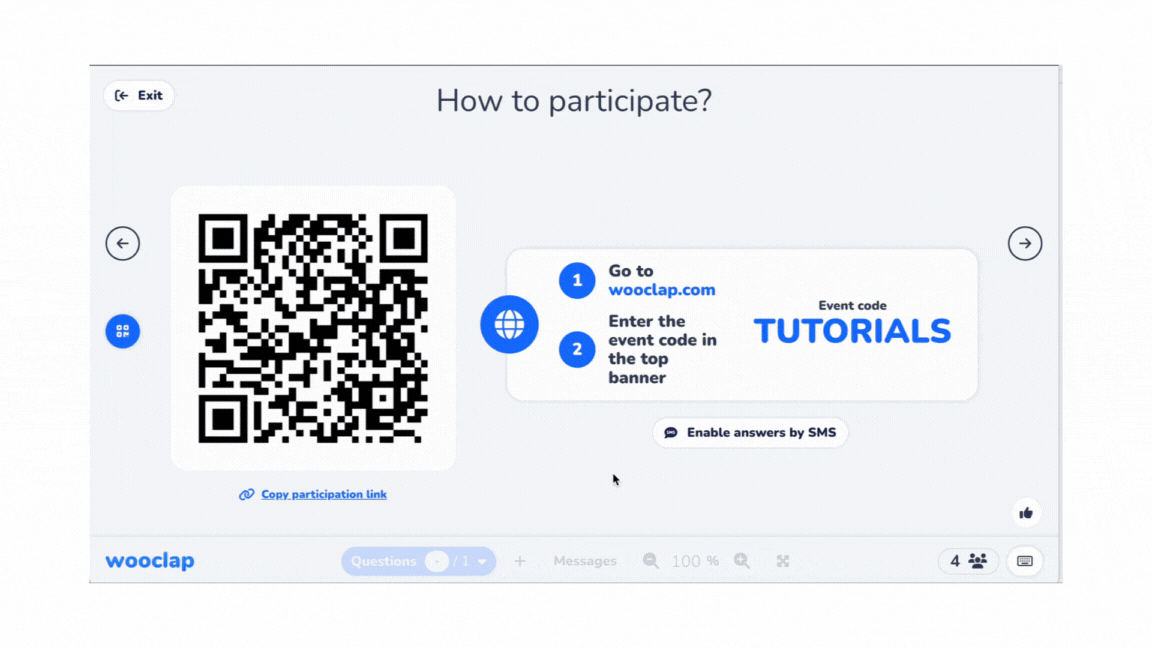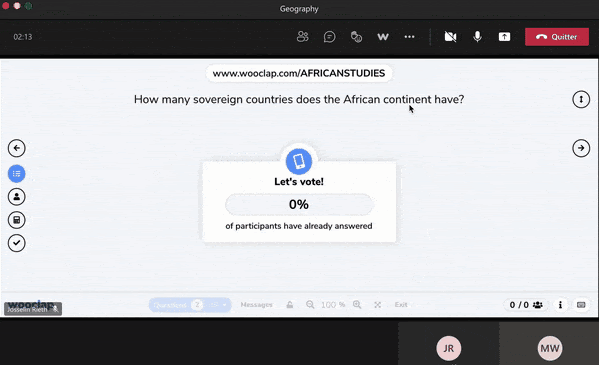Jamboard vs Miro vs Wooclap: A Definitive Comparison for 2024
27.02.2024 • 8 minutes

Jamboard and Miro have become synonymous with real-time collaboration over the last few years. However, while testing both, we found that each platform is designed to address the needs of two completely different audiences.
Miro offers an unlimited whiteboard and advanced collaboration features for organizing mind maps and brainstorming. Additionally, it comes with real-time and asynchronous communication features for easy team communication — especially when working remotely. This feature set makes Miro a great choice for product and development teams looking to organize and present ideas collaboratively.
On the other hand, we have Google Jamboard, which is a completely free whiteboard solution built for organized team collaboration. It has multiple limited whiteboards chained together into “frames”, which allows for more focused brain dumps around defined topics. Plus, its integration with the Google ecosystem allows participants to pull files from Google Drive, Search, or Docs, and talk via Google Meet. This combination of features made it a go-to for teachers or team leaders who wanted to make their online lectures or meetings collaborative and interactive.
However, Google announced Jamboard will be going dark at the end of this year. Miro is an alternative but its feature set doesn’t fully cover what Jamboard allows: structured learning and collaboration on organized whiteboards.
This is why we included Wooclap in the mix.
Wooclap offers multiple question types—including whiteboards and brainstorming frameworks—that can be chained together to structure team meetings, online lectures, and brainstorming sessions, and allow participants to engage with presentations in real time.
We tested and reviewed all three platforms in the following categories:
But before we dive into each category, let’s look at a quick overview of Jamboard vs Miro vs Wooclap.
Comparison Summary: Jamboard vs Miro vs Wooclap
| Jamboard | Miro | Wooclap |
 |  |  |
Price | ||
🏆 ⭐️⭐️⭐️⭐️⭐️ Completely free platform with access to all whiteboarding tools and integrations. | ⭐️⭐️⭐️ Offers a free version. Paid plans start at $10/month with unlimited boards and custom templates. | ⭐️⭐️⭐️⭐️ Offers a free version. Paid plans start at €6.99/month for educational institutions and €9.99/month for businesses. |
Whiteboard and Canvas Tools | ||
⭐️⭐️⭐️ Offers basic whiteboarding tools like a pen, eraser, sticky notes, images, and text boxes. | ⭐️⭐️⭐️⭐️ Offers advanced brainstorming tools like mind maps, user story maps, and charts. | 🏆 ⭐️⭐️⭐️⭐️⭐️ Offers useful whiteboarding tools with response tracking. Choose from 20 Question types for every collaborative use case. |
Event Creation and Management | ||
⭐️⭐️⭐️ Offers “frames” where participants can engage in no-idea brainstorming sessions. | ⭐️⭐️⭐️⭐️ Offers a blank board with templates and tools to collaborate with participants. | 🏆 ⭐️⭐️⭐️⭐️⭐️ Dedicated event pages with predefined workflows for structured collaboration with large groups. |
Collaboration | ||
⭐️⭐️⭐️ Offers only real-time collaboration features with multiple participants. | 🏆 ⭐️⭐️⭐️⭐️⭐️ Offers real-time and asynchronous collaboration with live chat, video calls, comments, and tags. | ⭐️⭐️⭐️⭐️ Offers the best real-time collaboration with competition, team, and message wall modes but doesn’t allow asynchronous collaboration. |
Integrations | ||
⭐️⭐️ Only offers Google Workspace integrations. | ⭐️⭐️⭐️⭐️ Integrates with Google Workspace, Microsoft 365, Atlassian, and more. | 🏆 ⭐️⭐️⭐️⭐️⭐️ Integrates with PowerPoint, video conferencing platforms, and LMS tools. |
Best for | ||
Teachers and businesses looking for a simple tool for collaborative whiteboarding. | Product and development teams looking for mind mapping tools. | Educational institutions and businesses that need a tool to collaborate in meetings, lectures, and presentations. |
What is Jamboard?

Google released Jamboard in 2017 to foster real-time online whiteboards and collaboration between participants already using Google Workspace.
Jamboard is a simple platform, offering basic whiteboarding options like sticky notes, a pen, an eraser, and text boxes. Ideas can be organized with “frames” — multiple limited whiteboards that work like presentation slides. Being a Google product, it lets participants share files from Google Drive, Docs, Search, Sheets, and more, while collaborating with Google Meet. It also offers an optional physical board connected to the Google Ecosystem for an immersive in-person brainstorming experience.
Jamboard’s features are a perfect mix for corporate brainstorming sessions or online classrooms where students can engage in the learning session.
What is Miro?

Miro (formerly RealtimeBoard) started in 2011 as a platform to communicate ideas to clients who aren’t in the room and later evolved into a robust visual brainstorming workspace for teams of any size.
Miro boasts a great collaboration feature library, starting with a comprehensive whiteboarding tool for mind maps, user story maps, and other templates for an immersive brainstorming session. It offers both real-time and asynchronous collaboration features so team members can communicate via live chat, video calls, video and audio walkthroughs, and comments and threads. It also offers a selection of third-party integrations to seamlessly integrate into any business workflow. With many different templates available, you can use Miro for project management, customer journey mapping, a Kanban board, and more.
Miro is perfect for product and development teams looking to create mindmaps and brainstorm project plans that clients and team members can understand. With its well-developed real-time and asynchronous collaboration tools, it’s ideal for remote teams.
What is Wooclap?

In 2015, Sébastien Lebbe and Jonathan Alzetta started Wooclap to develop a science-backed tool and help teachers capture and retain student attention. After their success in education, Wooclap expanded to collaborative business environments and now serves over 50 million users worldwide — including organizations like Maastricht University, Total Energies, and Kellogg’s.
It offers multiple ‘question types’ (including whiteboards), which can be chained together into interactive presentations or events to engage participants and encourage active learning. Participants can share ideas from third-party platforms thanks to Wooclap’s integrations with popular presentation, LMS, and video conferencing platforms. Once a session ends, organizers are provided detailed reports with participant inputs for further analysis and personalized feedback.
This feature set makes Wooclap a great choice for educational institutions and businesses that want to make their lectures, team meetings, and corporate training interactive and engaging while keeping it organized and focused.
Jamboard vs Miro vs Wooclap: Canvas and Whiteboarding Tools
| Jamboard | Miro | Wooclap |
| ⭐️⭐️⭐️ | ⭐️⭐️⭐️⭐️ | ⭐️⭐️⭐️⭐️⭐️ |
Jamboard offers basic whiteboarding options, Miro has advanced whiteboarding tools, and Wooclap offers templates for focused and interactive discussions.
If you like simplicity, the Jamboard canvas is for you.
It has a clean look with all the basic whiteboard features, including a pen, an eraser, sticky notes, images, and text boxes. Whiteboards can also be chained together with “frames”, which work like presentation slides, so participants focus on one idea before moving on to the next.
It’s great for quick brainstorming sessions or collaborative learning.

However, Jamboard doesn’t have a template library, so you have to find and upload your own. On the other hand, Miro and Wooclap have in-house and user-made template libraries for specific tasks and purposes.
Miro offers more whiteboarding tools to choose from during team discussions. Apart from the basics like text boxes and sticky notes, you can engage users in a more immersive brainstorming experience with mind maps, charts, and user story maps.

However, we found it difficult to navigate since all content is stored on one large board — unlike Jamboard and Wooclap which let you separate ideas across frames. (This also means Miro isn’t the most ideal as a collaborative learning tool.)

Meanwhile, Wooclap is more than just a whiteboard tool. It lets you create collaborative events where participants can brainstorm using 20 different question types, including whiteboards.
Like Jamboard and Miro, Wooclap’s Whiteboard has tools to draw shapes, insert text, and add images. However, unlike Jamboard, you can create a discussion workflow with predetermined questions.

Take Wooklap’s Frameworks tool for example.
It’s tailored for businesses where open collaboration frameworks like SWOT analysis, Porter’s 5, and business model canvases are common techniques. Participants can engage with these by answering questions, leaving comments, and voting for their favorite ideas.
Compared to a limitless open whiteboard, this creates a more productive and focused environment and reduces distractions.

Miro and Jamboard don’t offer response tracking, while Wooclap lets you download and analyze user inputs and performance.
Something both Miro and Jamboard lack is response tracking. They don’t offer a way to organize and analyze user inputs like comments and likes. That’s where Wooclap shines!
Wooclap’s Report and Grid functions compile all user responses in a separate ‘Results’ tab where you can analyze responses by question and participant (1). If you want to dive in deeper, you can download the responses (2) as an Excel or PDF file. It also offers a nifty feature to send individual reports to each participant for instant feedback.

Wooclap pretty much offers the same functionality as Jamboard and Miro but also supports streamlined workflows, multiple question types, and predesigned templates to enable better collaboration and discussions. Plus, it is the only one of the three that offers response tracking and post-event analysis features for organizers to understand participants’ understanding and engagement with the event.
Jamboard vs Miro vs Wooclap: Event Creation & Management
| Jamboard | Miro | Wooclap |
| ⭐️⭐️⭐️ | ⭐️⭐️⭐️⭐️ | ⭐️⭐️⭐️⭐️⭐️ |
All three support events but Jamboard calls them “Jams” while Miro refers to them as “Boards.” To keep things simple, we will refer to them as “events” in this article.
Before exploring how events work in each platform, let’s look at how easy it is to set up an event.
Jamboard links to your Google account, Miro offers a tailored onboarding process, and Wooclap provides quick overviews of each tool and option.
Honestly, we found all three were easy to set up.
Jamboard is a Google product. So all you need is a Google account to log in and get ‘jamming.’
Miro took a little longer because it tailors onboarding to your requirements.
It also has more features and takes more time to get used to the layout. It does offer some tips and tricks to help you navigate the whiteboard but doesn’t explain each tool — you need to figure it out yourself.

Meanwhile, Wooclap helps you get started with your first event quickly.
Its interface is straightforward and doesn’t require any guided walkthrough like Miro. But Wooclap still has your back with useful descriptors to give a quick overview of each option in case you need it.

Jamboard and Miro don’t have dedicated event pages, while Wooclap lets you create events for specific requirements.
Both Jamboard and Miro don’t have dedicated event pages.
Miro offers a blank, unlimited board where you can add elements as you go or choose from templates to quickly start collaborating with your team members. It isn’t very organized and is better suited for brainstorming than anything else.

Meanwhile, Jamboard offers a limited blank board to start but allows you to divide them into slides for specific discussions. Its minimalistic approach and frames are more suited for structured brainstorming sessions or live online classrooms.

In Wooclap, an event is where you collaborate and interact with attendees and team members.
Each event can consist of multiple slides (called Questions) to encourage a productive discussion. You can go with simple formats like a Q&A and multiple choice questions, or choose more detailed frameworks like word clouds, whiteboards, polls, and more.
Wooclap events are a great place to collaborate in large groups with rotating or varying members — for example: university lectures, conference workshops, corporate coaching, or market surveys.

Wooclap wins this particular category. It lets you create event pages with dedicated question workflows to facilitate a more focused collaboration between participants. You can use Q&A, multiple-choice questions, word clouds, polls, and more to keep participants engaged and allow them to collaborate in the learning session.
Jamboard vs Miro vs Wooclap: Collaboration
| Jamboard | Miro | Wooclap |
| ⭐️⭐️⭐️ | ⭐️⭐️⭐️⭐️⭐️ | ⭐️⭐️⭐️⭐️ |
Jamboard lets participants collaborate in real-time.
Jamboard works like any other Google product — you share editor access with participants, like you would on Google Docs or Sheets. Once they have access, participants can join the ‘jam’ session and collaborate in real-time.

Another way Jamboard enriches the collaboration experience is by integrating with other Google features.
For example, you can search for images on Google Search or Drive right from Jamboard and add them to your “jam.” You can also share data from Docs, Sheets, and Slides, and get on calls via Google Meets.
Miro offers both real-time and asynchronous collaboration features.
Miro allows multiple participants to work on a project simultaneously. You can speak to each other via real-time chat or video calls, or tag users on elements that need attention.

When it comes to communication and feedback management, Miro also offers asynchronous communication methods like threaded conversations and comments to easily share ideas while keeping discussions organized across different time zones. To share more in-depth information, you can create audio or video walkthroughs of a Miro board using the Talktrack feature.

Wooclap offers the best live collaboration features but doesn’t support asynchronous collaboration for participants.
Wooclap offers two types of collaborations:
As an author, you can invite multiple collaborators to curate an event. With their interactive editing roles, they can add, delete, or modify questions as they see fit. The author can validate any changes for an added layer of scrutiny.
But Wooclap’s true power is on display while participating in an event. Apart from comments and messages, it offers a unique collaboration experience with social features like:
- Team mode where participants can join a team to answer questions during an event.
- Competition mode where participants can compete with each other, displaying the ranking of the best players in a leaderboard.
- Message Wall where attendees can share images, questions, and comments. They can also leave likes to prioritize questions during the session.

Miro wins in a collaborative whiteboards category. It offers both real-time and asynchronous collaboration features like video walkthroughs, video calls, live chat, and comments, so participants can communicate ideas in an organized manner either during the event or after it.
Jamboard vs Miro vs Wooclap: Integrations
| Jamboard | Miro | Wooclap |
| ⭐️⭐️ | ⭐️⭐️⭐️⭐️ | ⭐️⭐️⭐️⭐️⭐️ |
Jamboard only offers Google Workspace integrations while Miro integrates Microsoft, Google, and Atlassian products.
Jamboard only integrates with Google Workspace products like Google Docs, Drive, and such. Participants can add content from Google Search to the whiteboard.
On the other hand, Miro offers integrations for any conceivable purpose, including Microsoft, Google, and Atlassian products. For example, its Google Calendar integration lets you share Miro boards with your meeting invite so participants can go through the board and even add topics they’d like to discuss.

Wooclap offers integrations that facilitate real-time interactions on third-party apps.
Wooclap’s integrations allow teachers to create and publish quizzes directly on learning management (LMS) platforms like Moodle, Blackboard, and Canvas. They can also import questions from the LMS to Wooclap.
However, the setup is intensive as Wooclap follows the Learning Tools Interoperability (LTI) specifications prescribed by 1EdTech. But you have access to detailed instructions in the Help Center walking you through how to integrate your LMS.

For live sessions and webinars, Wooclap offers Zoom, Teams, and Google Meet integrations, where users can access quizzes, polls, and multiple-choice questions. You can also share surveys and questionnaires as events, which will be added to the participant’s calendar.

Finally, Wooclap also supports a PowerPoint integration where users can add Wooclap questions to their presentation to create a more interactive session.

Wooclap offers native integrations with PowerPoint, video conferencing platforms like Microsoft Teams and Zoom, and LMS like Moodle and Blackboard. It allows participants to interact with Wooclap content without leaving the third-party app.
Jamboard vs Miro vs Wooclap: Pricing
| Jamboard | Miro | Wooclap |
| ⭐️⭐️⭐️⭐️⭐️ | ⭐️⭐️⭐️ | ⭐️⭐️⭐️⭐️⭐️ |
Jamboard is a free platform with some paid add-ons.
Jamboard as a software is free! All you need is a Google account to use both the web-based desktop and Jamboard app. Once you log in, all features are available. A simple solution for anyone on an expense tracking spree.
However, if you opt for the Jamboard device One Board 65, which is a digital whiteboard hardware, the cost starts at $4,999. This price includes a Jamboard display, 2 styluses, an eraser, and a wall mount. There’s also an additional annual management and support fee of $600.
Miro has a simple pricing model with three paid plans.
| Free | Starter | Business | Enterprise |
$0/month Unlimited team members + 5 Talk tracks + 100+ integrations + Interactive presentation mode | $10/month Unlimited editable boards + Private mode + Unlimited project folders + Custom templates | $20/month 2000+ diagramming shapes + Advanced board exporting + Timer + Advanced search | Price on demand Planner + Video chat + Admin insights + Board history |
Wooclap structures its pricing plans based on the use case.
Wooclap offers more affordable plans for educational institutions than businesses but there isn’t any difference in features.
| Free | Basic | Pro | Custom | |
€0/month Unlimited events + Max 2 questions + Real-time vote | €6.99/month All Free features + Unlimited questions + Unlimited events | €14.99/month All Basic features + Moderator + SMS + Email support | Price on demand All Pro features + Unlimited participants + LMS integration | |
€0/month Unlimited events + Max 2 questions + Real-time vote | €9.99/month All Free features + Unlimited questions + Unlimited events | €24.99/month All Basic features + Moderator + SMS + Email support | Price on demand All Pro features + Unlimited participants + LMS integration |
It also offers a separate pricing plan for one-off events:
| Free | Basic | Pro | Premium |
€0/event Max 2 questions + Unlimited events + Real-time vote | €149/event All Free features + PDF reports + Chat support | €249/event Colleague collaboration + Custom color theme + Moderator | €749/event All Pro features + 1000 participants + Phone support |
Jamboard offers a free plan with limited features that’s ideal for students and solopreneurs on a budget while Wooclap structured its pricing plan to cater to educational institutions, businesses, and event planners.
Jamboard vs Miro vs Wooclap: Pros & Cons
 | |
| Jamboard Pros | Jamboard Cons |
✅ Completely free platform | ❌ Basic whiteboarding tools |
✅ Offers a physical whiteboard product | ❌ No interactive elements |
✅ Integrates with Google Workspace | ❌ No native templates |
 | |
| Miro Pros | Miro Cons |
✅ Advanced brainstorming tools like mind maps, user story maps, etc. | ❌ Higher learning curve |
✅ Real-time & asynchronous collaboration | ❌ No response tracking |
✅ Microsoft 365, Google Workspace, Atlassian, and digital asset management integrations | ❌ Interface is difficult to navigate |
 | |
| Wooclap Pros | Wooclap Cons |
✅ Dedicated event pages | ❌ Basic whiteboarding tools |
✅ Comprehensive reporting features | ❌ Difficult LMS integrations |
✅ Third-party app integrations | |
✅ 20 Question types for focused discussions | |
Jamboard vs Miro vs Wooclap: Final Verdict
| Jamboard | Miro | Wooclap |
Best for: Teachers and businesses looking for a simple tool for collaborative whiteboarding. | Best for: Product and development teams looking for mind-mapping tools. | Best for: Educational institutions and businesses that need a tool to collaborate in meetings, lectures, and presentations. |
If you’ve reached this far, you might have realized that Jamboard, Miro, and Wooclap are three platforms with similar collaboration tools serving different audiences.
We tested all three and compared them side-by-side to reach our conclusion. However, your situation might be different and you might come to a different one. So we encourage you to test all three and see which one fits your needs the best.
Between these three popular tools, here’s our final verdict:
Use Jamboard if:
- You’re a teacher with a limited budget in need of an online collaboration tool for your students.
- You’re a team leader who needs a simple whiteboard tool to organize brainstorming sessions.
- You’re running a presentation and want to engage your participants.
- You only need the tool until the end of 2024.
Click here to get started with Jamboard!
Use Miro if:
- You’re in a product, marketing, or business development team in need of a mind-mapping tool.
- You need an unlimited whiteboard with real-time and asynchronous collaboration.
- You’re looking to include all members of distributed teams in your brainstorming sessions.
- You don’t want pre-planned and organized sessions or presentations.
Click here to get started with Miro!
Use Wooclap if:
- You’re a team leader in need of tools to structure business meetings and brainstorm complex solutions.
- You’re a corporate coach, instructor, or consultant and need an interactive platform to run your presentations.
- You’re a lecturer teaching complex topics and want a tool that integrates with your presentations to increase students’ knowledge retention and get feedback on their understanding during and after the session.
Writer

The Wooclap team
Make learning awesome & effective
Subject
A monthly summary of our product updates and our latest published content, directly in your inbox.


